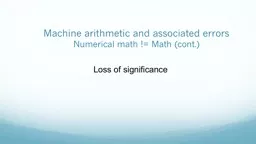

errors Numerical math Math cont Loss of significance In Previous Lectures Absolute and relative errors You considered and ran the code numderivativecc observed two types of errors ID: 780394
Download The PPT/PDF document "Machine arithmetic and associated" is the property of its rightful owner. Permission is granted to download and print the materials on this web site for personal, non-commercial use only, and to display it on your personal computer provided you do not modify the materials and that you retain all copyright notices contained in the materials. By downloading content from our website, you accept the terms of this agreement.
Slide1
Machine arithmetic and associated errorsNumerical math != Math (cont.)
Loss of significance
Slide2In Previous Lectures:Absolute and relative errors.You
considered and ran the code
numderivative.cc
;
observed two types of errors –
truncation
and
round-off
error.
Floating-point representation of real numbers in decimal in binary forms.
Consequences of
a finite space
in computer memory for representing real numbers:
1) the
hole at zero,
2) the
smallest and the largest real numbers,
3) machine
epsilon
.
Slide3Errors in numderivative.ccThe code calculates
F’(x) =
lim
_{h-->0} (F(
x+h
)-F(x)) /
h
using
approximate
equation for
finite
values of
h:
F
’(x)
=~
(F(x
+ h) -
F(x
))/
h
More accurate
equation
for
F’(x)
with
finite
h
can
be derived
from a
“better” formula
F(x
+ h) =~ F(x) + h*F
’
(x)
+ h^2*F’’(x)/2!
leading to
F
’(x) =~
[F(x
+ h) - F(x
)]/h
+
h*
F’’(x)/2
!
Missed in our code
blue term
gives us a
truncation error
which
goes
down
with
h
.
The error calculating the first term is
the error in subtraction
(or “+”) operation.
Slide4Machine epsilon
1
+
e
mach
>
1emach for a single precision or emach for a double precision
Slide5Significant digitsSuppose we have a real number X represented in normalized floating point form:
X = 0.1234567 x 10^-2
Digits 1, 2, 3, 4, 5, 6, 7 have
different significance
because they represent different power of 10.
We can say that digit in the first position after decimal point (digit 1) is the
most
significant digit. The significance diminishes from left to right. Here digit 7 is the least significant digit.
Slide6Significant digits
For a
mathematically exact
real number X, its approximate decimal form can be given with as many significant digits as we wish or need.
E.g., for the number pi:
pi
0.314159265 x 10^1
The situation is different if X is a measured quantity.
Slide7Significant digitsSuppose we measure a length of a desk with a ruler with metric scale and the smallest distance between ruler marks is 1mm.Suppose the result of our measurement is 1m 21
c
m 4mm or L=1.214 m
What is wrong if we write down this number as
L = 0.1214238 x 10^1
?
Slide8Significant digitsSuppose we measure a length of a desk with a ruler with metric scale and the smallest distance between ruler marks is 1mm.
Suppose the result of our measurement is 1m 21
c
m 4mm or L=1.214 m
What is wrong if we write down this number as L = 0.1214238 x 10^1
?
It’s misleading.
Why? Because the precision of our measurement is only 1mm or 0.001m and we have only 4 significant digits in the value of L.Definition: significant digits are digits beginning with the leftmost nonzero digit and ending with the rightmost correct digit. The quantity L=0.1214238 x 10^1 m is accurate to 4 significant digits. We can trust a total of 4 digits as being meaningful.
Slide9Significant digits Example: diagonal of a square
D=s *
= 0.736 * 1.4142135623
… = 1.040861182 ... ?
D=1.041 m or (more conservatively, 3 significant digits!) D=1.04 m
s=0.736 m - length of the side of the square D
Slide10Loss of significanceLet us consider how a computational subtraction
leads to a loss of significance (the number of significant digits) and how this loss can be reduced or eliminated.
Suppose we subtract two very close numbers X1 and X2. Each have
24
significant binary digits (or 7 decimal digits)
X1 = (0.1b
2
b3b4b5…..... b20b21b22b23b24 ) x 2^k X2 = (0.1b2b3b4b5…..... b20b21b22b23b24 ) x 2^k Z = (0.0000000…......... 0b21b22b
23
b
24
) x
2^k
Is Z accurate? Yes. But it has only 4 significant binary digits (about 1 decimal digit). I.e. Z=X1-X2 lost 20 significant binary digits (about 6 decimal digits).
Numerical subtraction can lead to a loss of significance!
-
=
Slide11Loss of significanceExample: X=0.6353 and Y=0.6311 (4 significant decimal digits)Z = X – Y = 0.0042 (only 2 significant decimal digits), 2 significant digits are lost
A good way to estimate how close are X and Y or how many significant digits will be lost is to calculate the value of the function
|1– (Y/X)|
= 0.0066110
…
This number starts at 3-d decimal digit. First two decimal digits are lost.
Slide12Loss of significanceLet us consider a function
f(x)=
sqrt
(x*x
+ 1.0) -
1.0
evaluated
in the code loss_of_significance.cc (see class web page).At x near zero this function subtracts two very close numbers resulting in a complete loss of significance at x=1.00E-4 ( x=1.0*10^{-4} ).Why? What can we do to decrease (eliminate) this loss?We can rewrite the function f(x) in another form which avoids subtractionUse the relation: => =
)/
And write a
better_form_of_f
(x)
= x^2 /(
sqrt
(x*x + 1.0)
+
1.0
)
Slide13Summary of today ClassWe considered a concept of significant digits in a real numbersLoss of significance
at
subtraction
operation and how it can be
avoided